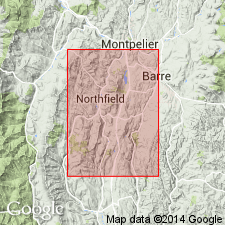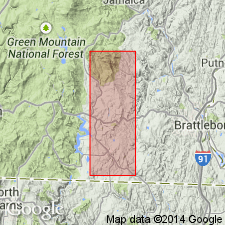
- Usage in publication:
-
- Cram Hill formation
- Modifications:
-
- Named
- Dominant lithology:
-
- Slate
- Phyllite
- Schist
- Quartzite
- AAPG geologic province:
-
- New England province
Summary:
Named the Cram Hill formation for Cram Hill, Washington Co., VT. Consists of gray to black slate and phyllite grading downward into quartz-chlorite-sericite schist; thin to massive quartzite beds at bottom, siliceous volcanics at top. Greenstone dikes are locally abundant. Thickness is 1500 to 2600 feet. Overlies unnamed Ordovician(?) schists and underlies the Shaw Mountain formation. Unit is equivalent to the upper part of the "Missisquoi" schists of Richardson (1919). The Cram Hill is of Ordovician age.
Source: GNU records (USGS DDS-6; Reston GNULEX).

- Usage in publication:
-
- Cram Hill Formation*
- Modifications:
-
- Overview
- AAPG geologic province:
-
- New England province
Summary:
The Cram Hill Formation in Windham Co., VT consists of homogeneous, rusty, tan- to dark-gray weathering, pyritiferous, carbonaceous, ilmentite-chlorite-plagioclase-muscovite-quartz schist with distinctive fissile parting along cleavage surfaces. Locally contains 1 to 10 cm thick plagioclase-quartz-muscovite granofels some of which are graded and contain abundant angular and rounded blue-quartz pebbles. Unit is typically cross-cut by mafic dikes and sills of the North River Igneous Suite. Overlies the Moretown Formation. The Cram Hill is of Ordovician age.
Source: GNU records (USGS DDS-6; Reston GNULEX).
For more information, please contact Nancy Stamm, Geologic Names Committee Secretary.
Asterisk (*) indicates published by U.S. Geological Survey authors.
"No current usage" (†) implies that a name has been abandoned or has fallen into disuse. Former usage and, if known, replacement name given in parentheses ( ).
Slash (/) indicates name conflicts with nomenclatural guidelines (CSN, 1933; ACSN, 1961, 1970; NACSN, 1983, 2005, 2021). May be explained within brackets ([ ]).

